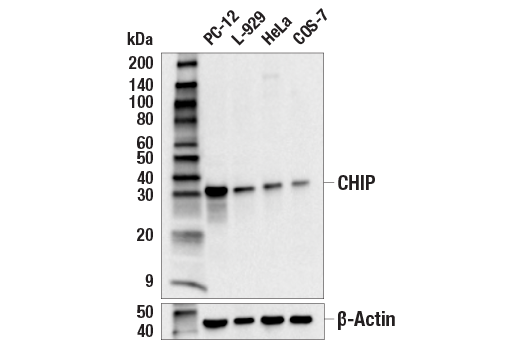WB, IP
H M R Mk
Endogenous
32
Rabbit IgG
#Q9UNE7
10273
Product Information
Product Usage Information
| Application | Dilution |
|---|---|
| Western Blotting | 1:1000 |
| Immunoprecipitation | 1:100 |
Storage
Specificity / Sensitivity
Species Reactivity:
Human, Mouse, Rat, Monkey
Source / Purification
Monoclonal antibody is produced by immunizing animals with a synthetic peptide corresponding to residues around Leu36 of human CHIP.
Background
The carboxy terminus of Hsc70-interacting protein (CHIP, STUB1) is a co-chaperone protein and functional E3 ubiquitin ligase that links the polypeptide binding activity of Hsp70 to the ubiquitin proteasome system (1). Cytoplasmic CHIP protein contains three 34-amino acid TPR (tetratricopeptide repeat) domains at its amino terminus and a carboxy-terminal U-box domain. CHIP interacts with the molecular chaperones Hsc70-Hsp70 and Hsp90 through its TPR domain, while E3 ubiquitin ligase activity is confined to the U-box domain (2,3). The binding of CHIP to Hsp70 can stall the folding of Hsp70 client proteins and concomitantly facilitate the U-box dependent ubiquitination of Hsp70-bound substrates (4-6). CHIP appears to play a central role in cell stress protection (7) and is responsible for the degradation of disease-related proteins that include cystic fibrosis transmembrane conductance regulator (4), p53 (8), huntingtin and Ataxin-3 (9), Tau protein (10), and α-synuclein (11).
- McDonough, H. and Patterson, C. (2003) Cell Stress Chaperones 8, 303-8.
- Ballinger, C.A. et al. (1999) Mol Cell Biol 19, 4535-45.
- Murata, S. et al. (2001) EMBO Rep 2, 1133-8.
- Meacham, G.C. et al. (2001) Nat Cell Biol 3, 100-5.
- Younger, J.M. et al. (2004) J Cell Biol 167, 1075-85.
- Jiang, J. et al. (2001) J Biol Chem 276, 42938-44.
- Dai, Q. et al. (2003) EMBO J 22, 5446-58.
- Esser, C. et al. (2005) J Biol Chem 280, 27443-8.
- Jana, N.R. et al. (2005) J Biol Chem 280, 11635-40.
- Shimura, H. et al. (2004) J Biol Chem 279, 4869-76.
- Shin, Y. et al. (2005) J Biol Chem 280, 23727-34.
Species Reactivity
Species reactivity is determined by testing in at least one approved application (e.g., western blot).
Western Blot Buffer
IMPORTANT: For western blots, incubate membrane with diluted primary antibody in 5% w/v BSA, 1X TBS, 0.1% Tween® 20 at 4°C with gentle shaking, overnight.
Applications Key
WB: Western Blotting IP: Immunoprecipitation
Cross-Reactivity Key
H: human M: mouse R: rat Hm: hamster Mk: monkey Vir: virus Mi: mink C: chicken Dm: D. melanogaster X: Xenopus Z: zebrafish B: bovine Dg: dog Pg: pig Sc: S. cerevisiae Ce: C. elegans Hr: horse GP: Guinea Pig Rab: rabbit All: all species expected
Trademarks and Patents
Limited Uses
Except as otherwise expressly agreed in a writing signed by a legally authorized representative of CST, the following terms apply to Products provided by CST, its affiliates or its distributors. Any Customer's terms and conditions that are in addition to, or different from, those contained herein, unless separately accepted in writing by a legally authorized representative of CST, are rejected and are of no force or effect.
Products are labeled with For Research Use Only or a similar labeling statement and have not been approved, cleared, or licensed by the FDA or other regulatory foreign or domestic entity, for any purpose. Customer shall not use any Product for any diagnostic or therapeutic purpose, or otherwise in any manner that conflicts with its labeling statement. Products sold or licensed by CST are provided for Customer as the end-user and solely for research and development uses. Any use of Product for diagnostic, prophylactic or therapeutic purposes, or any purchase of Product for resale (alone or as a component) or other commercial purpose, requires a separate license from CST. Customer shall (a) not sell, license, loan, donate or otherwise transfer or make available any Product to any third party, whether alone or in combination with other materials, or use the Products to manufacture any commercial products, (b) not copy, modify, reverse engineer, decompile, disassemble or otherwise attempt to discover the underlying structure or technology of the Products, or use the Products for the purpose of developing any products or services that would compete with CST products or services, (c) not alter or remove from the Products any trademarks, trade names, logos, patent or copyright notices or markings, (d) use the Products solely in accordance with CST Product Terms of Sale and any applicable documentation, and (e) comply with any license, terms of service or similar agreement with respect to any third party products or services used by Customer in connection with the Products.

